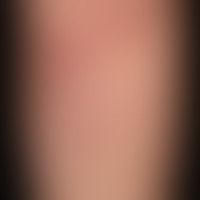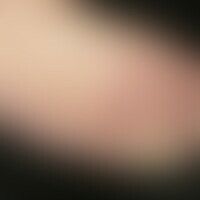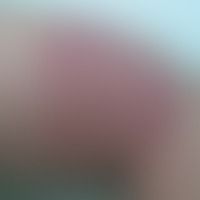Image diagnoses for "Plaque (raised surface > 1cm)", "red", "Leg/Foot"
125 results with 293 images
Results forPlaque (raised surface > 1cm)redLeg/Foot
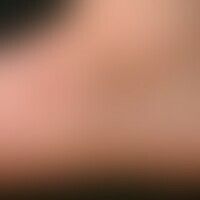
Tinea pedis (overview) B35.30
Tinea pedum, detail enlargement: Sharply defined, marginal scaly erythema, pustular formation, scaly seam along the edge of the foot and multiple scratch excoriations, some of which are crusty.

Tinea pedis (overview) B35.30
Tinea pedum. general view: Persistent redness and scaling, partly with severe itching, in the area of the left foot in a 30-year-old female patient, which has not healed for about 13 years. sharply defined, marginal scaling erythema, pustular formation.

Varicella B01.9
Varicella: generalized exanthema (aspects of erythema multiforme) with coexistence of larger and smaller papules, vesicles, plaques.

Nodular vasculitis A18.4
erythema induratum. solitary, chronically stationary, 4.0 x 3.0 cm in size, only imperceptibly growing, firm, moderately painful, reddish-brown, flatly raised, rough, scaly nodules with a deep-seated part (iceberg phenomenon). intermediate painful ulcer formation (Fig). no evidence of mycobacteriosis.

Eosinophilic cellulitis L98.3
Cellulitis eosinophil: acute formation of circumscribed, large, sharply margined plaques The surface of the plaques may have an orange peel-like texture (see following figure)

Acrodermatitis chronica atrophicans L90.4
Acrodermatitis chronica atrophicans: Initially flat, oedematous, livid red plaques; beginning transition to pronounced, flaccid atrophy with typical wrinkling of the skin (cigarette-paper phenomenon) and clearly translucent vein networks.

Lichen planus exanthematicus L43.81
Lichen planus exanthematicus: since 2 months persistent, itchy, generalized, dense rash with emphasis on trunk and extremities (face not affected). here formation of large reddish PLaques. in the marginal area the plaques dissolve into papules. the typical shine of the Lichen planus efflorescence is very well visible.

Erythema multiforme, minus-type L51.0
Erythema multiforme: multiple red plaques with central blistering, the lesions are confluent on the left and right edge of the image.

Primary cutaneous marginal zone lymphoma C85.1
Primary cutaneous marginal zone lymphoma: localized red (surface smooth) plaque with circulatory margins, known for several months and only moderately consistent, no evidence of systemic involvement.
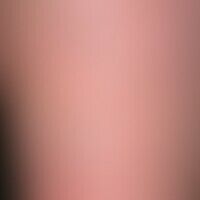
Papillomatosis cutis lymphostatica I89.0
Papillomatosis cutis lymphostatica. detail enlargement: brownish-red papules and plaques. in the center of the picture isolated scratch excoriations.
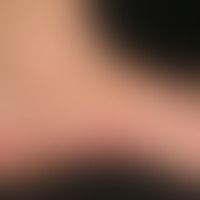
Lichen planus (overview) L43.-
Lichen planus exabthematicus: unusual infestation of the soles of the feet, with itchy, red, in places confluent, smooth, shiny papules and plaques; skin lesions extend beyond the skin of the groin

Primary cutaneous diffuse large cell b-cell lymphoma leg type C83.3
Primary cutaneous diffuse large cell B-cell lymphoma leg type: Survey image : Since about 12 months persistent, slowly progressing, about 4-5 cm in diameter, irregularly shaped, bulging, deep red tumor with smooth surface in a 75-year-old patient with a central atrophic, scar-like aspect.

Psoriasis vulgaris chronic active plaque type L40.0
Psoriasis vulgaris chronic active plaque type: relapsing activity after angina tonsillaris, partly larger plaques and disseminated papules.

Necrobiosis lipoidica L92.1
Necrobiosis lipoidica: detailed picture with pronounced atrophy of the surface epithelium.
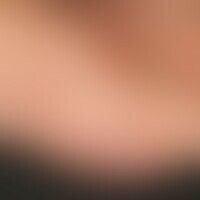
Larva migrans B76.9
Larva migrans. general view: Acutely occurring, itchy, dynamically increasing, linear, firm, livid red plaque on the right back of the foot, existing since 3 weeks, after a beach holiday in Thailand.

Vasculitis leukocytoclastic (non-iga-associated) D69.0; M31.0
Vasculitis, leukocytoclastic (non-IgA-associated). multiple, acute, symmetric, since 2 weeks existing, localized on both lower legs, irregularly distributed, 0.1-0.2 cm large, sharply defined, symptomless, hemorrhagic spots and blisters as well as beginning incrustations.

